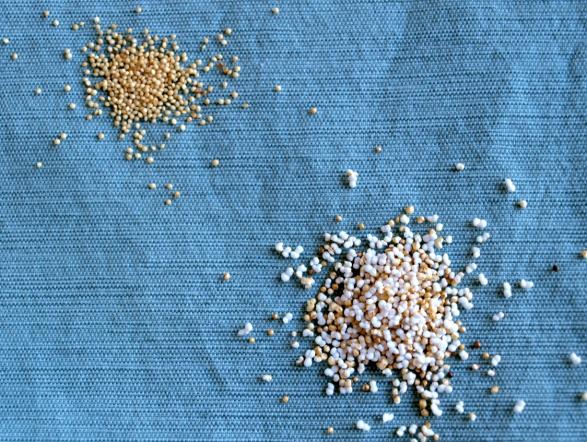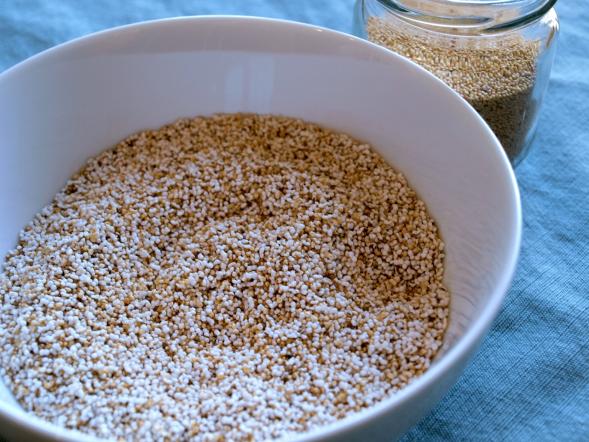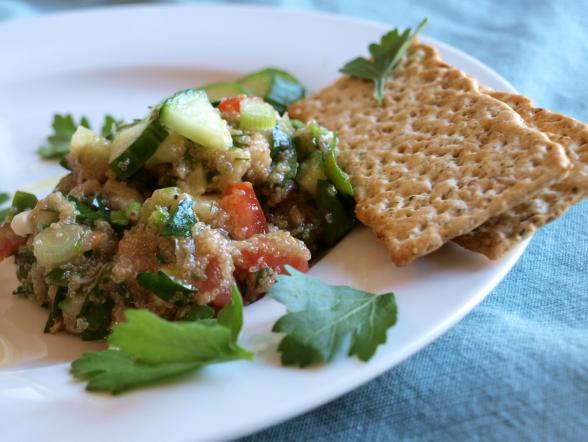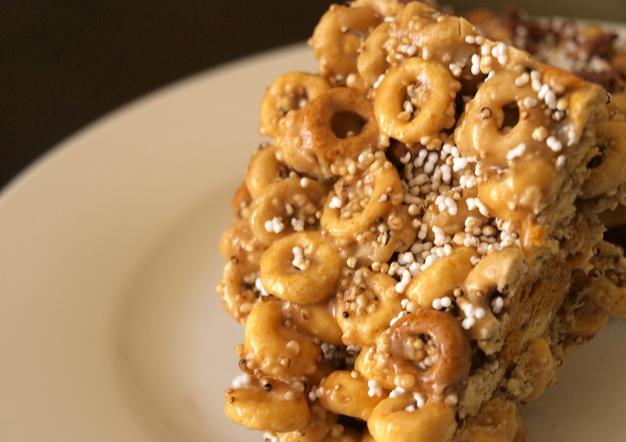One of the things I love about writing about food is trying new ingredients. When I run across something at the farmers’ market or in the grocery aisle I haven’t cooked before, it almost always ends up in my cart. When amaranth (pronounced ah-mah-ran-th) found its way into my kitchen last month, I was skeptical but curious about what this tiny grain had to offer.
Trying new ingredients usually ends up one of three ways in my kitchen:
1) I get obsessed with the grain, cook with it like crazy, and find ways to add it to all my favorite recipes. That’s what happened when I discovered barley, and now it’s on our table once a week or more.
2) I’m pleasantly surprised. I make a few good meals and then move on.
3) I decide there’s a reason I never tried it before and probably won’t bother with it again. Teff is a shining example of this. I made it once and haven’t eaten it since.
Somehow, amaranth managed to end up falling in all three categories. The first day I opened the package of tiny granules, I was a little underwhelmed and on my way towards reaction #3. Amaranth’s not much different in purpose or form than the other whole grains I’ve tried in this series. I wasn’t sure if it really had anything special to offer.
 Raw amaranth (left) and popped amaranth (right)
Raw amaranth (left) and popped amaranth (right)
Then I figured out I could pop amaranth just like popcorn, one of my favorite foods ever. My reaction jumped straight to outcome #1 – total obsession – and made five amaranth dishes in the next two days. My husband can testify that our kitchen was covered with little bits of amaranth for days and that I was 100% convinced amaranth was the next kale or foie gras.
A few weeks later and I’ve settled on a comfortable #2. I love that amaranth—when heated to the perfect temperature—tastes just like nutty popcorn. I love that it’s gluten free and stirs well into many dishes. But after my amaranth craze, it’s likely going to stay on the pantry shelf for a while.
To be honest, I’m not entirely sure what it is about amaranth that it faded so quickly. It could be that after more than a year of focused cooking with whole grains, I’ve found my favorites and the rest don’t quite compare. It could also be that unlike some of the other grains, amaranth is not native to Minnesota, and eating it falls outside our regular diet. It’s more of a novelty item; a neat thing to try, I’m just not sure it has the staying power in our kitchen. Then again, it could always be the next big thing for someone else.
What is amaranth?
Amaranth falls in the “grey area” of whole grains. It’s not a cereal grain like oats, rye, and wheat, but because it has some of the same features (bran, germ, and nutrients) as the other whole grains, we include it as a whole grain anyway. People eat amaranth differently around the globe. In India and Nepal, it’s made into porridge. But it’s played the largest role in South and Central America both culturally and politically. In Aztec culture, amaranth is used in many celebrations and at one time shared the same value as corn. During the 16th century, it was banned by Spanish colonists and nearly disappeared. Now farmers increasingly grow amaranth in South and Central America as a substitute for the more popular quinoa, which is expensive and more difficult to grow.
What’s great about it?
Amaranth has found its way back into American kitchens as a superfood. High in protein (almost 3 times higher than wheat) and in the amino acid lysine, amaranth is also gluten free. Just like other whole grains, there’s a long list of studies that show how diets high in amaranth can lower cholesterol, improve heart health, and act as a good supplement for animal protein.
Where can I find it?
Most area grocery and natural foods stores sell dried amaranth. It typically comes in a 1-3 pound package of tiny dried granules, ready to be popped or boiled. Amaranth seeds are also available at many nurseries, as many flower gardeners enjoy the bloom and foliage of the plant.
 Popped Amaranth
Popped Amaranth
What do I do with it?
Amaranth cooks quickly in boiling water and can be used 1:1 in almost any recipe calling for quinoa. It can also be ground into a gluten-free flour and substituted 1:1 for whole wheat flour. If you’re trying to decide if amaranth has staying power in your kitchen, here’s some other ideas to get you started:
· Popped Amaranth – Popping amaranth takes some trial and error, however the end taste is almost identical to popcorn. Each amaranth kernel is like a microscopic piece of popcorn, ready to be buttered and salted. To pop amaranth, heat a small pot with a lid until a tiny drop of water immediately evaporates when dropped in the bottom. Add in 1 tablespoon of amaranth and immediately put on the lid. Shake the pot back and forth over the burner for 10-20 seconds or until the popping just starts to slow. The pot has to be the right temperature: too cold and the amaranth will just slowly scorch; too hot and it burns instantly.
· Alegria – Alegria is a popular street food in Latin countries. It’s made by covering popped amaranth and pumpkin seeds with a boiling sugar and molasses mixture and then allowing that to harden into a sweet, chewy bar.
 Amaranth Tabouli
Amaranth Tabouli
· Amaranth Tabouli – Add 2 cups of cooked and cooled amaranth to roughly chopped tomatoes, cucumber, parsley, and mint. Stir in ½ cup olive oil, salt, and pepper to taste. Refrigerate for an hour before serving cold on a leaf of lettuce.
· Amaranth Tortillas – Combine 1 ¼ cups of amaranth flour with ½ cup of water and favorite seasonings into a thick paste. Roll into a golf ball size and the press onto a hot griddle (no oil) to form tortillas. Cook until browned on both sides and little or no moisture remains in the tortilla.
 Gooey Amaranth Bars
Gooey Amaranth Bars
· Gooey Amaranth Bars – Stir 2 cups popped amaranth in with 6 cups of your favorite breakfast cereal and 4 cups of melted marshmallows for a whole grain twist on Rice Crispy treats.
· Amaranth Bean Soup – Make your favorite black bean or cannellini bean soup recipe. While the beans are cooking stir in ½ cup of uncooked amaranth to add extra creamy texture and flavor while naturally thickening the soup.

Amy Sippl is a frequent contributor to Simple, Good, and Tasty. She grew up in rural Wisconsin, but now calls St. Paul her home. She writes about her successes and struggles to eat and grow local food on her blog: Minnesota Locavore. She writes the Great Grains series for SGT; her last non-grain post for us was Co-op on a Budget: Your DIY Headquarters.

